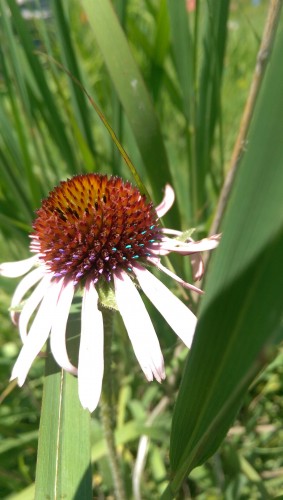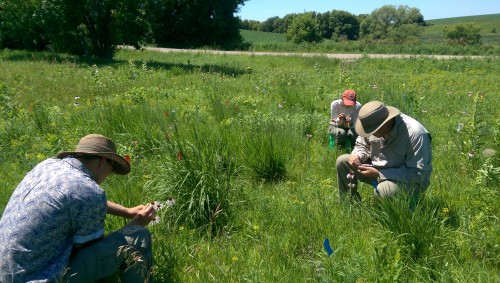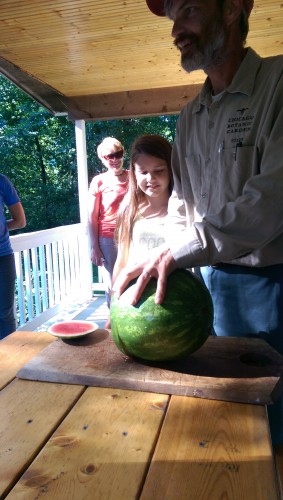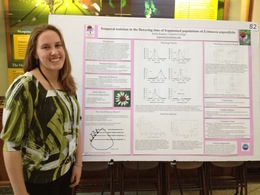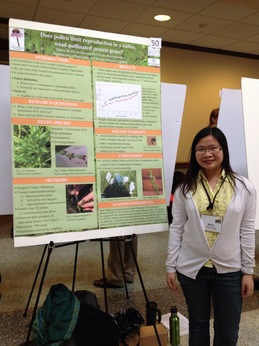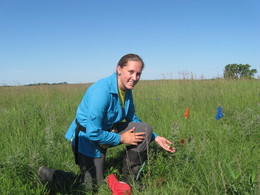|
|
 My beautiful bracts!  Ben, Gina, & Matt practice precise painting Today was another successful day with the team! We had a morning filled with phenology at half of the sites and later everyone divided to get many things accomplished. After lunch, some of us practiced painting the bracts of Echinacea; this wasn’t too hard, it was actually very pleasant. Using toothpicks, we had to be sure to paint the tops of bracts as well as the bottom while making sure not to get paint on the florets or apply too much.
 I see absolutely nothing wrong here. Here, Lea and I were at p2 collecting phenology data in the afternoon. There are 80 rows in this plot and it took us almost the whole day to get the job done! I’m from the south and it honestly takes a lot for me to confess that a place is hot, but the way the sun was blazing today, I wasn’t sure if I’d make it out of the prairie to deliver this flog post to you! It was so “warm” today I was seeing double headed Echinacea…….. sheesh.
To conclude a week full of accomplishments, Stuart sliced up the best watermelon ever. One shouldn’t argue this watermelon’s caliber; I know this was the best watermelon ever because it replenished all the sense I lost in p2 today. I’d say that everyone else enjoyed this glorious melon as well! Today was a good Friday!
 Watermelon after work!
This past weekend, three students associated with the Echinacea Project presented their work at the Midwest Ecology and Evolution Conference at Notre Dame.
Kelly Kapsar (Carleton College, 2014) spent the winter analyzing her data on flowering phenology in prairie remants and presented her results in a poster.

Maria Wang (Northwestern, 2013) presented the results of her undergraduate honors thesis on pollen limitation in the prairie grass Dicanthelium.

Master’s student Katherine Muller gave an oral presentation on her research on the relationship between Echinacea and its specialist aphid.

I should mention that Maria was recently accepted as a Master’s student in the Northwestern Program in Plant Biology and Conservation. She will graduate this summer and remain in Chicago another year to finish her M.S.. She will be working with Dr. Nyree Zerega investigating the genetic origins of tropical crops. Although we will miss her in the Echinacea Project, we wish her the best in her next endeavor.

Hallo once again from K-town! It was yet another wonderfully nice day out in the prairie of Minnesota. This morning, Maria and Katherine headed out to the Landfill site to GPS all of the flowering plants we found earlier (about 80 of them this year). Kelly, Jill, and I headed over to Around Landfill to do demography on the plants Kelly used for her phenology project. And Shona and Andrew won (at long last) a battle with our second GPS unit (which arrived yesterday), Chekov. Chekov has come to join Sulu in our endeavors to gain coordinates. But it’s best if both work properly. Oh, and Kelly’s last plant at all her remnants finished flowering today! It’s bittersweet.


We came back to the Hjelm House later in the morning and had time to work on getting things ready and wrapped up for our poster presentations on Thursday. Yoiks! It’s coming up quick! Ruth came up with Lisa, and undergrad, and Dave, a potential post-doc for the Echinacea Project. After lunch, Dave gave us his presentation on his work with Solidago velutina (goldenrod). We then headed over to Aanenson to do demography. There were not very many flowering plants there this year, though Jill and I found a monster of one on the side of the road. We had both GPS units out with us, but we had a ton of trouble with them and were only able to GPS a few plants. We’ll just blame it on solar flares again. Once finished, we reconvened at the Hjelm House for some nummy watermelon fresh from the garden! Maria also found something interesting while we were out. We’re thinking these might be egg sacs of some sort, but we’re not quite sure.

Now that the vast majority of Echinacea are finished flowering (except for the populations at Staffanson and one lonely plant at Northwest of Landfill), I’ve started piecing together a master datasheet with the first and last day of flowering for every Echinacea head that I have been studying. Please let me know if you have any comments or recommendations for statistical analysis, possible comparisons to other data sets, or better organizational methods!
phen_mastersheet_2012.csv
phen_mastersheet_2012_metadata.doc
This summer I’m going to continue with Amber Z’s phenology research from last year. I’ve added on two new sites: North Northwest of Landfill and Around Landfill. I started taking data on June 18th when there were only a couple of plants beginning to flower, but now, many more plants have started flowering and a couple are even close to finishing!
Kelly’s Flowering Phenology Project Proposal.doc
Hello all! A lot has happened since my last post, so here is a brief update!
After returning to school with my phenology data and experimental seed heads in the fall of 2011, I began work on my senior thesis using that data as a foundation. In April of this year I defended my thesis, “Flowering Phenology and Seed Set in Fragmented Populations of the Prairie Plant Echinacea angustifolia” and was awarded Distinction by my committee! Stuart and I continued to work on my data after my defense and are planning to continue the project and potentially incorporate data from this summer in the hopes of publishing it! Here are some of the very interesting results that we’ve gotten so far:
> aggregate(ss ~ nndist + pdtime, data = mm, mean)
nndist pdtime ss
1 far early 0.1637403
2 near early 0.2690535
3 far late 0.2947009
4 near late 0.1802392
We found that there’s a relationship between seed set (ss), peak flowering date (pdtime), AND distance to the 6th nearest neighbor (nndist). Seed set was higher in plants that had a combination of close 6th nearest neighbor (near) and early peak flowering date or far 6th nearest neighbor (far) and late flowering date. Very interesting!
(table is categorical and matches glm model which looks at pd & nn6 as continuous)
If anyone has any questions, is interested in continuing this exciting project this summer, or would like a copy of my thesis, feel free to contact me! (Amber Zahler at ambermzahler@gmail.com)
|
|

